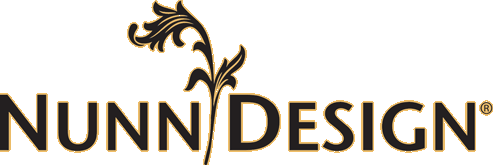Texturized Resin in Open Hoops
This technique was discovered when I was in a creative panic over my resin setting up. I was losing my “resin window” as the resin started to get thick and hard within the mixing up. I was curious to see what would happen if I tried a variety of different things with my soon to be resin waste. This technique of Texturized Resin in an Open Frame Hoop was one of the projects that came out rather neat.
Get Supplies Read Instructions Be InspiredVideo Tutorial
Instructions
In this tutorial you will be learning:
- How to mix resin
- A new technique for using up every drop of resin
- How to add texture to resin
- How to clean and drill resin
Learn How:
There are 4 sizes within the Open Frames Hoops. Each hoop is brass and plated with copper, 24k gold and .999 fine silver.
Step 1:
Select a design from the Clay Squisher texturizing pads. Nunn Design is a distributor of Judikin’s Clay Squishers, a heavy duty textured rubberstamping sheet. Clay Squishers are ideal for this texturized resin technique.



Step 2:
Applying baby powder to the rubber Clay Squisher will make it easier for the curing resin to release from the pad. Pour some baby powder onto a plastic bag. Place your fingers into the plastic bag and fully coat your fingers with the baby powder. Apply the baby powder onto the areas of the Clay Squisher that you want to pick-up the texture of the design.


Step 3:
Pick-up the Clay Squisher and turn it on its side. Bump the Clay Squisher against the surface of the table to remove any excess baby powder.

Place the Nunn Design Open Frame Hoops onto the baby-powdered areas of the Clay Squisher.

Step 4:
Read the resin instructions for safety concerns regarding the Nunn Design Resin.

When I work with resin, I always:
- Place a large plastic bag over my work surface and tape it down.
- I make sure I have ventilation in my workroom.
- I wear gloves.
- I wear glasses (readers because I can’t see anymore. Plus it protects my eyes!).
- I have a pile of wet wipes handy.
- This is a great blog post that covers 20 Habits for Successfully Using Nunn Design 2-Part Epoxy Resin. Even if you are a seasoned resin mixer, this might be worth a read.
- You can also watch this great video on How to Mix Nunn Design Resin!
Step 5:
Place one cup (included in the Nunn Design Resin Kit) onto your table.

For curing purposes, it is very important that the resin be an exact 1 to 1 ratio of Part A and Part B. I suggest getting your eyes level with the resin so you can see the lines on the measuring cup.
Pour Part A of your resin kit up to the ½ fluid ounce mark on your measuring cup.
Pour Part B of your resin kit into the same cup until it is filled to the 1 fluid ounce mark. It is important to pour Part A first and then Part B. It is some chemical thing about the part A being heavier or something.

Step 6:
Set your timer for 2 minutes. Using the stir stick from your kit (a popsicle stick or coffee stir stick will work great too), slowly and carefully stir your resin scraping the sides as you stir. Stir for a minimum of 2 minutes. If your resin is still cloudy continue to mix until clear.

After mixing is complete and your resin is clear, scrape both sides of your stir stick on the edge of your resin filled cup.
Step 7:
In order for the resin to not seep out from under the edges of the Open Frame Hoop and for it to peel away from the Clay Squisher easily once it is in the soft cured state, the resin needs to be really thick before applying it to the rubber surface.
TIP: Resin must be thick prior to pouring or it will stick to the Clay Squisher.
Using a stir stick, scoop up the resin from within the mixing cup and drizzle the thick resin onto the powder-covered Clay Squisher. Spread the resin around with a stir-stick until the resin is even in height within the Open Frame Hoop. I also use my stir stick or a toothpick to agitate the resin along the edges of the Open Frame Hoop, causing air that might be trapped in those areas to dislodge and rise to the surface of the resin.


Step 8:
You will want to ‘babysit’ your resin for the next 1 – 2 hours. If you see bubbles rising to the surface, using your hot breath, breathe on them. It isn’t a “blow” sort of breath – more of a “huff” sort of a breath.

The hot air will make the bubbles expand, rise to the surface and pop. As the resin starts to set-up and become thicker, it will be more difficult for the air to rise to the surface. Make sure to check in on the curing resin and double check for air bubbles. If you do have some bubbles, use a toothpick to gentle drag them over to the sides. This agitation process will help them to pop. When the resin is thick and taffy like in texture it is time to let it be. If you attempt to pop bubbles at this time, you may end up with a gooey mess.

Step 9:
Set a timer for 6 hours.
Let the resin cure on the Clay Squisher for 6 hours or until the resin is firm to the touch. If the resin is too soft and slightly tacky, wait an hour and try again. This stage of the curing resin process is referred to as the “soft cure” stage.
TIP: Resin must be peeled from the Clay Squisher and cut during the soft cure phase. It will continue to cure and will become brittle over the next 48 hours, making it impossible to remove from the Clay Squisher and to cut.

Step 10:
After 6 hours of curing, while in the soft-cure stage and the resin is firm to the touch, bend back the Clay Squisher at one of the edges of the Open Frame Hoop, peeling it away from the resin.

You will know the resin is ready to release and peel away from the Clay Squisher when you start to see resin turn lighter in color. It is doing this because it is releasing from the rubber pad.



Step 11:
While still in the soft-cure stage (6 hours of curing), if you had any resin seep out from under the open hoop, use a pair of scissors to cut away the excess resin. Make sure to wipe down your scissors – removing any resin bits after cutting.

Step 12:
If the resin has sharp edges, use the finest steel wool to lightly sand the areas.

Step 13: Black Residue
Once the resin is fully cured and hard to the touch, if you have a little black residue from the texturizing pad on your resin, you can remove it by using a coarse ott of steel wool.

TIP: This isn’t a perfect technique. It is unpredictable. I have done two pieces side by side, same resin batch, same cure time, same room temperature. The only things that I can guess that have caused the resin to pull black from the rubber (mind you, I’m still figuring this out too!!!) is:
1. Maybe I had more baby powder on the one that released better?
2. Maybe the rubber on the clay squishers were of various ages?
3. Maybe the resin was thicker?
Honestly, I don’t know why sometimes it works and sometimes it doesn’t. I have used #00 steel wool to sand the resin to remove the rubber, but it still isn’t crystal clear. Keep me posted on what you experience.
After you have used the steel wool to sand the black residue off of your resin, clean with a wet-wipe.
Step 14:
To clean the resin of any steel wool residue, apply some rubbing alcohol onto a Q-Tip and apply.

Step 15:
After the resin is fully cured and hard to the touch, you will be ready to drill a hole to attach a jumpring. Select an appropriate sized drill bit to fit the gauge of wire of the jumpring you intend to attach.

You will also want to think about the drilling position of the resin, making sure that there will be enough room for the jumpring to thread through the resin and for chain to be thread through the jumpring. Once you have your drill bit inserted into the drill place the open hoop filled with resin onto a wood block. Place the bit on the resin where you want to drill. Holding onto the Open Frame Hoop, drill straight down and through the resin. The holes should be clean and smooth.



Drill straight down and all the way through the resin (you will feel when you have hit the wood) and back up again. Attach a jumpring and thread your chain through for a great focal of texturized resin!

Tip: Make sure you have a jump ring large enough to fit through your hole and with a big enough diameter.










































